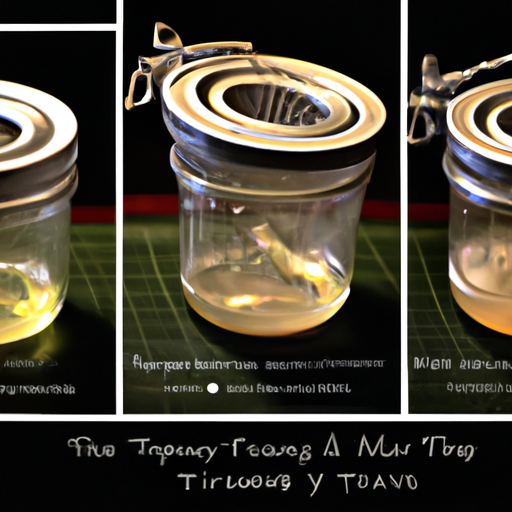Welcome! In this article, we’ll be discussing effective homemade fly traps. You’ll learn different methods and ingredients that you can use to create simple and efficient fly traps right at home. From using basic household items to natural solutions, we’ll guide you through the process and help you keep those pesky flies away. So, get ready to make some handy fly traps and enjoy a fly-free environment!
Why Use Homemade Fly Traps
Flies are a common household nuisance, buzzing around and contaminating our living spaces. While there are many commercial fly traps available on the market, they can often be expensive and come with potentially harmful chemicals. This is where homemade fly traps come in. They offer a cost-effective and eco-friendly alternative to tackling fly infestations while also being customizable to your specific needs.
Cost-effective solution
One of the main advantages of homemade fly traps is their cost-effectiveness. Instead of purchasing expensive commercial traps, you can create effective traps using common household items. This not only saves you money but also allows you to make multiple traps to cover different areas of your home.
Eco-friendly alternative
Another benefit of homemade fly traps is their eco-friendly nature. Commercial fly traps often contain harmful chemicals that can be harmful to the environment. By opting for homemade traps, you can use natural ingredients that are safe for the environment. This not only reduces your ecological footprint but also ensures the safety of your family and pets.
Customizable to specific needs
Homemade fly traps allow you to customize your traps according to your specific needs. You can experiment with different recipes and ingredients to find what works best for you. Additionally, you can create traps of various sizes and designs to target different areas in your home.
Types of Homemade Fly Traps
There are various types of homemade fly traps that you can easily construct using everyday household items. Here are three popular options:
Vinegar Fly Trap
The vinegar fly trap is a simple and effective method for catching flies. To create this trap, you will need a plastic bottle or jar, apple cider vinegar, sugar, and a small amount of dish soap. Start by cutting small holes in the top half of the bottle or jar. Next, pour apple cider vinegar into the bottom half of the container and add a teaspoon of sugar. Lastly, add a few drops of dish soap to break the surface tension and trap the flies. Secure the top of the trap and place it in areas where flies are commonly seen.
Fruit Jar Fly Trap
The fruit jar fly trap is another popular option that utilizes ripe fruits to attract flies. For this trap, you will need a wide-mouthed jar, ripe fruits, plastic wrap, and a small tool to poke holes. Begin by placing pieces of ripe fruits at the bottom of the jar. Then, cover the jar with plastic wrap and secure it with a rubber band. Finally, poke small holes on the plastic wrap to create entry points for the flies. Place the trap in areas where flies are frequently spotted, and they will be drawn to the scent of the ripe fruits.
Paper Cone Fly Trap
The paper cone fly trap is a quick and easy trap that can be constructed using a simple piece of paper. To create this trap, roll a sheet of paper into a cone shape, making sure to secure the edges with tape or glue. Place a small amount of bait, such as sugar water or ripe fruit, at the bottom of the cone. Position the cone over the bait, making sure the opening is narrow enough for the flies to enter, but not exit easily. Place this trap in areas where flies are a problem, and they will be lured into the cone and trapped.
Ingredients for Homemade Fly Traps
To create effective homemade fly traps, you will need a few key ingredients. These ingredients are easily available and are likely already stocked in your pantry. Here are the essential ingredients:
Apple cider vinegar
Apple cider vinegar is a highly effective ingredient for attracting and trapping flies. Its strong odor is irresistible to flies, making it the perfect bait for your homemade traps. You can find apple cider vinegar in most grocery stores or even make it yourself using apple scraps.
Ripe fruits
Ripe fruits, such as bananas or oranges, are highly attractive to flies due to their sweet smell. By using ripe fruits as bait in your traps, you can effectively lure the flies in and trap them. Additionally, the use of ripe fruits adds a natural touch to your homemade traps.
Sugar
Sugar is another ingredient that can be used to attract flies. Its sweet scent is irresistible to flies, making it an excellent addition to your homemade traps. You can use granulated sugar, brown sugar, or even make a sugar water solution to use as bait.
Cardboard or paper
Cardboard or paper is essential for constructing certain types of homemade fly traps, such as the paper cone fly trap. These materials are readily available and easy to work with. Make sure to choose sturdy cardboard or thick paper to ensure the traps hold up well.
Constructing a Vinegar Fly Trap
The vinegar fly trap is one of the easiest homemade traps to construct. Follow these simple steps to create your own vinegar fly trap:
Gather necessary materials
To construct a vinegar fly trap, you will need a plastic bottle or jar, apple cider vinegar, sugar, and a small amount of dish soap. Ensure you have all these items ready before you begin.
Cut holes in the bottle or jar
Using scissors or a sharp knife, carefully cut small holes in the top half of the bottle or jar. These holes should be large enough for the flies to enter but not so large that they can escape easily.
Pour vinegar and add bait
Next, pour apple cider vinegar into the bottom half of the bottle or jar. Add a teaspoon of sugar to attract the flies to the trap. The odor of the vinegar combined with the sweetness of the sugar will entice the flies to investigate further.
Secure the top and place the trap
Secure the top half of the bottle or jar onto the bottom half, making sure the holes align with the top half. Use tape or glue if necessary to ensure a tight seal. Place the trap in areas where flies are commonly seen, such as near garbage bins or outdoor dining areas. The flies will be attracted to the scent of the vinegar and trapped inside the container.
Setting up a Fruit Jar Fly Trap
The fruit jar fly trap is another effective homemade trap that utilizes ripe fruits as bait. Follow these steps to create your own fruit jar fly trap:
Prepare a wide-mouthed jar
Start by selecting a wide-mouthed jar that will allow flies to enter easily. Clean and dry the jar thoroughly before proceeding.
Place ripe fruits inside
Cut or break ripe fruits into small pieces and place them at the bottom of the jar. The scent of the ripe fruits will lure the flies inside the jar.
Cover the jar with plastic wrap
Cover the jar with a piece of plastic wrap, making sure it is large enough to completely cover the opening. Use a rubber band to secure the plastic wrap tightly around the jar.
Poke small holes on the plastic
Using a small tool, such as a toothpick or pin, poke small holes on the plastic wrap. These holes will serve as entry points for the flies. Make sure the holes are small enough to prevent the flies from escaping easily.
Place the trap in areas where flies are commonly found, such as near fruit bowls or kitchen counters. The flies will be attracted to the scent of the ripe fruits and will enter the jar through the small holes on the plastic wrap.
Creating a Paper Cone Fly Trap
The paper cone fly trap is a simple and effective homemade trap that can be constructed using just a sheet of paper. Follow these steps to create your own paper cone fly trap:
Roll a sheet of paper into a cone
Start by taking a sheet of paper and rolling it into a cone shape. Make sure the cone has a narrow opening and a wide base.
Secure with tape or glue
Once you have rolled the cone, secure the edges with tape or glue to ensure it holds its shape. This will prevent the flies from escaping once they have entered the trap.
Place bait at the bottom
At the base of the cone, place a small amount of bait to attract the flies. This can be sugar water, a small piece of ripe fruit, or any other sweet-smelling substance that flies are attracted to.
Position the cone over the bait
Carefully position the cone over the bait, making sure the opening is narrow enough for flies to enter but not exit easily. Place the trap in areas where flies are commonly seen, such as near kitchen windows or outdoor dining areas. The flies will be lured into the cone by the scent of the bait and will become trapped inside.
Best Locations for Fly Traps
To get the most out of your homemade fly traps, it is important to place them in the right locations. Here are some of the best areas to position your traps:
Kitchen and dining areas
The kitchen and dining areas are common hotspots for flies, especially if there are open food sources. Place your traps near these areas to catch any flies that are attracted to the smell of food. This will prevent flies from contaminating your food and spreading bacteria.
Garbage or recycling areas
Flies are often attracted to the smell of garbage and rotting food. Placing traps near your garbage or recycling bins will help to minimize the number of flies in these areas. This is particularly important in warm climates or during the summer months when flies are most active.
Outdoor living spaces
If you have outdoor living spaces, such as patios or decks, flies can become a nuisance. Positioning traps in these areas can help to keep flies at bay and allow you to enjoy your outdoor spaces without constant fly interruptions. Remember to choose traps that are weather-resistant if they will be exposed to the elements.
By strategically placing your homemade fly traps in these key areas, you can effectively minimize fly populations and keep your living spaces fly-free.
Maintaining and Disposing of Fly Traps
To ensure the effectiveness of your homemade fly traps, it is essential to maintain and dispose of them properly. Here are some tips for maintaining and disposing of your traps:
Regularly clean and refill traps
Fly traps can become dirty and ineffective over time. Clean your traps regularly by emptying and rinsing them out. Refill the traps with fresh bait to maximize their effectiveness. Apple cider vinegar or ripe fruits should be replaced every few days to maintain their scent and attractiveness to flies.
Properly seal and discard used traps
When it is time to dispose of your used traps, it is important to seal them properly to prevent any trapped flies from escaping. Place the trap in a sealed bag or container before disposing of it in an outdoor trash bin. This will help to prevent any lingering flies from becoming a nuisance.
Avoid contact with trapped flies
When handling used traps, avoid direct contact with the trapped flies. Flies can carry diseases and bacteria, so it is best to avoid any unnecessary exposure. Always wear gloves and make sure to wash your hands thoroughly after handling the traps.
Following these maintenance and disposal tips will help to prevent the spread of flies and ensure a clean and hygienic environment in your home.

Prevention and Additional Tips
While homemade fly traps are an effective solution for managing fly infestations, prevention is always better than cure. Here are some additional tips to help prevent flies from becoming a problem in your home:
Keep trash cans tightly closed
Flies are attracted to the smell of food waste and garbage. To prevent flies from congregating near your trash cans, make sure they have tight-fitting lids. This will help to contain any odors and discourage flies from entering.
Clean spills and surfaces regularly
Food spills and crumbs can quickly attract flies. Clean up spills and wipe down surfaces regularly to remove any food residue that may attract flies. This is particularly important in kitchen areas where food preparation takes place.
Use screens on windows and doors
Screens on windows and doors are an effective barrier against flies and other flying insects. Make sure your screens are intact and free of tears or holes. This will prevent flies from entering your home and reduce the need for fly traps.
Avoid leaving food exposed
Leaving food uncovered or exposed is an open invitation for flies. Store food properly in sealed containers and cover any leftovers or unfinished meals. This will help to prevent flies from being attracted to your food and eliminate potential breeding grounds in your home.
By implementing these preventive measures in conjunction with using homemade fly traps, you can significantly reduce and manage fly populations in your home.
Conclusion
Effective homemade fly traps offer a practical and eco-friendly solution for managing fly infestations. By utilizing common household items and natural ingredients, you can create cost-effective traps tailored to your specific needs. From vinegar fly traps to fruit jar traps and paper cone traps, there are various options to choose from. Remember to place your traps strategically in areas where flies are commonly found, such as kitchen and dining areas, garbage or recycling areas, and outdoor living spaces.
Regular maintenance and proper disposal of traps are essential to ensure their effectiveness. Additionally, taking preventive measures such as keeping trash cans closed, regular cleaning, using screens on windows and doors, and avoiding leaving food exposed will further help to keep your space fly-free in the long run.
With homemade fly traps and these additional tips, you can enjoy a fly-free environment that is safe and comfortable for you and your family. Take action today and say goodbye to those pesky flies!








